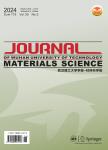Microstructure and Mechanical Properties of Nb-B bearing Low Carbon Steel Plate: Ultrafast Cooling versus Accelerated Cooling
Microstructure and Mechanical Properties of Nb-B bearing Low Carbon Steel Plate: Ultrafast Cooling versus Accelerated Cooling作者机构:State Key Laboratory of Rolling and Automation Northeastern University Laboratory for Excellence in Advanced Steel Research Center for Structural and Functional Materials Research and Innovation and Department of Metallurgical and Materials Engineering University of Texas at El Paso
出 版 物:《Journal of Wuhan University of Technology(Materials Science)》 (武汉理工大学学报(材料科学英文版))
年 卷 期:2017年第32卷第3期
页 面:619-624页
核心收录:
学科分类:08[工学] 080502[工学-材料学] 0805[工学-材料科学与工程(可授工学、理学学位)]
基 金:Funded by National Natural Science Foundation of China(No.51234002) National Key Research and Development Program of China(No.2016YFB0300602)
主 题:TMCP ultra fast cooling M/A constituent low temperature toughness
摘 要:The microstructure and mechanical properties of low carbon bainite high strength steel plate were studied via different cooling paths at the pilot scale. There was a significant increase in mechanical properties, and notably, the yield strength, tensile strength, and toughness at-40 ℃ for the tested steel processed by ultra-fast cooling were 126 MPa, 98 MPa and 69 J, respectively, in relation to steel processed by accelerated cooling. The ultra-fast cooling rate not only refined the microstructure, precipitates, and martensiteaustenite(M/A) islands, but also contributed to the refinement of microstructure in thick plates. The large size M/A constituents formed at lower cooling rate experienced stress concentration and were potential sites for crack initiation, which led to deterioration of low-temperature impact toughness. In contrast, the acicular ferrite and lath bainite with high fraction of high-angle grain boundaries were formed in steel processed by ultra-fast cooling, which retarded cleavage crack propagation.



